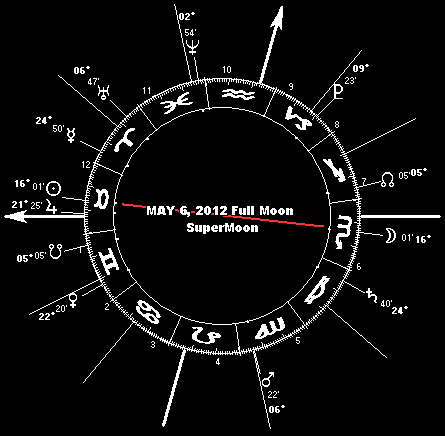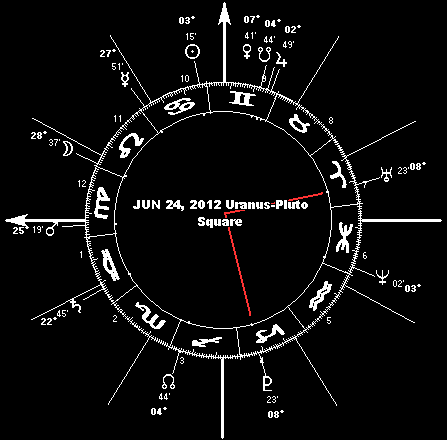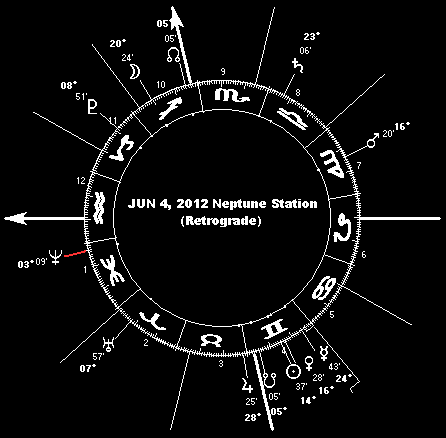If you were expecting some kind of sun sign nonsense, forget about it. This is real astrology for the real world, not some mystical mumbo-jumbo psycho-babble word salad. If it's real astrology for yourself that you want, you can get it by phone or in print. And if you need help deciphering the astrological glyphs in the graphics accompanying this article, see Astroglyphs: Astrological Symbols Guide. Please note: this forecast is expressed in terms of Universal Time (UT, aka GMT). Also please be aware that, while I never change a forecast once it's published, I do post errata to acknowledge typographical errors and the like.
PLEASE NOTE: This month’s forecast incorporates elements of (and refers to) my complete 2012 World Forecast Highlights (34 8-1/2 x 11” illustrated pages), focused, amplified and elaborated with details for the month as appropriate. If you’d like your own copy of the full 2012 World Forecast Highlights, it’s available in hard copy by mail ($75) or as a PDF document by email ($50). Orders may be phoned in (toll-free from anywhere in North America to 800-527-8761) and charged to any major credit card. PayPal orders may be placed direct from your own PayPal account page to rnolle@astropro.com – or by using the AstroPro PayPal order page.
That's the secret to life... replace one worry with another.
-- Charles M. Schulz
 May brings the second in the spring 2012 series of three consecutive full moon SuperMoons, and the first solar eclipse of the year; which just happens to be the first of two consecutive eclipses, one solar (the new moon on May 20th) and one lunar (the full moon SuperMoon partial lunar eclipse on June 4). It’s a combination of extreme solar-lunar alignments with our home planet that ups the ante for strong storm, seismic and tidal action this month. (I suspect that the biggest potential for notable storm, seismic and tidal extremes all year fits into this May-June series of notable Sun-Earth-Moon alignments.) You remember the first SuperMoon of the year, don’t you? It was described in the full version of my 2012 World Forecast Highlights, and further detailed in my free online April forecast.
May brings the second in the spring 2012 series of three consecutive full moon SuperMoons, and the first solar eclipse of the year; which just happens to be the first of two consecutive eclipses, one solar (the new moon on May 20th) and one lunar (the full moon SuperMoon partial lunar eclipse on June 4). It’s a combination of extreme solar-lunar alignments with our home planet that ups the ante for strong storm, seismic and tidal action this month. (I suspect that the biggest potential for notable storm, seismic and tidal extremes all year fits into this May-June series of notable Sun-Earth-Moon alignments.) You remember the first SuperMoon of the year, don’t you? It was described in the full version of my 2012 World Forecast Highlights, and further detailed in my free online April forecast.
Meanwhile, we’ve still got two notable Max cycles going on at once this month; namely Venus and Mars (both in effect all month). In fact, Venus comes to one of the several critical points in this particular Max cycle on May 15, the day of its retrograde station (the point at which Venus comes to an apparent standstill in the sky, and begins its period of retrograde (reverse) motion as seen from Earth. (Watch for Venus high and bright in the western sky after sunset: a sight to behold!) And as I mentioned in last month’s forecast, there’s also a Saturn and a Pluto Max going on – and Neptune’s as well, as far as that goes. But these outer planet Max cycles tend to be less sharply focused than those of the planets closest to Earth; namely Mercury, Venus and Mars.
Max cycles aside, what is arguably the year’s signature celestial configuration is the Uranus-Pluto square. As described in some detail in the complete version of my 2012 World Forecast Highlights, the Uranus-Pluto square that heralded the nearly worldwide economic dislocation, social and labor strife of the 1930s (including US troops firing on the Bonus Army Marchers) is the same configuration that’s in effect from 2011 into 2016. This particular waxing quadrature (90° arc) from Uranus to Pluto is exact on June 24 and September 19, but within a couple degrees from May through October.
 The historical association between anarchic uprisings and the Uranus-Pluto square is a bit of an over-simplification, to be sure. Every coin has two sides, and there’s more to look for in the time and tide of this particular celestial configuration than revolution and barricading the streets. Political programs aimed at redressing social and economic ills are also part of the picture, like the US WPA and CCC or the German Autobahn of the 1930s. Their analogs are surely in the works in 2012 and the years following. Likewise, breakthroughs in science and technology that will transform and transmute our lives, our minds, our understanding of the world within us and around us. The two extremes of the material scale – from quantum mechanics and particle physics to astrophysics – are where the breakthroughs are coming; along with the peculiar middle ground occupied by medicine and biotechnology. The fact remains that these – which are ultimately the bigger stories – won’t get much everyday media focus. It’s conflict that gets the Breaking News banners, and there will be plenty of that to go around – this month, and on-and-off for years to come.
The historical association between anarchic uprisings and the Uranus-Pluto square is a bit of an over-simplification, to be sure. Every coin has two sides, and there’s more to look for in the time and tide of this particular celestial configuration than revolution and barricading the streets. Political programs aimed at redressing social and economic ills are also part of the picture, like the US WPA and CCC or the German Autobahn of the 1930s. Their analogs are surely in the works in 2012 and the years following. Likewise, breakthroughs in science and technology that will transform and transmute our lives, our minds, our understanding of the world within us and around us. The two extremes of the material scale – from quantum mechanics and particle physics to astrophysics – are where the breakthroughs are coming; along with the peculiar middle ground occupied by medicine and biotechnology. The fact remains that these – which are ultimately the bigger stories – won’t get much everyday media focus. It’s conflict that gets the Breaking News banners, and there will be plenty of that to go around – this month, and on-and-off for years to come.
Another major outer planet development in process this month is Neptune’s retrograde station. It’s exact on June 4, but within less than a degree throughout May – and within a few degrees of an exact opposition to Mars as the month begins. In combination, these configurations point to social unrest and political upheaval, the 99% caught up in idealistic, unrealistic, morally justified but economically impractical umbrage: universal peace, justice and compassionate care for our fellow human beings are all wonderful things, with calculable price tags - but no one cares to figure and provide for the cost. There’s a dark side to this Neptune station as well, including disease outbreaks, poisonous clouds and fluids, medical murder and other covert acts of violence and destruction. Sure, these things are never far from the headlines. This month, they’re above the fold.
Last month’s SuperMoon is a good reminder of what to expect this month. The April 6 SuperMoon window (April 3-11) ushered in the world’s strongest earthquake of the year (Magnitude 8.6 off the coast of Indonesia), as well as tornadoes tearing through Texas and Argentina, and Japan reeling under the strongest windstorm there in more than 50 years. The May 6 SuperMoon full moon occurs at 16° 01’ Scorpio, and it’s the closest full moon of 2012 - a sight not to be missed in the eastern sky after sunset, as the Moon rises huge over the horizon; while at the same time Venus Max sets after the Sun in the west. With an effective geocosmic shock window opening up on May 1 (in advance of the Moon’s southward crossing of the celestial equator on the 2nd) and extending into the 9th, this will be a SuperMoon to watch closely. Lining up just a minute or so in time from the exact lunar perigee, and just over 12 hours from the Moon’s south declination peak, with a Mars (Max)-Neptune opposition in effect at the time, this particular SuperMoon augurs something extra, something in addition to the typical elevated SuperMoon risk of strong storms, extreme tides and news-making seismic activity (M 5+ earthquakes and volcanic eruptions). There’s something here about disruption to energy supplies, chemical accidents or attacks, and/or acts of violence that have geopolitical consequences. How much of this is weather related or seismically-induced – and some of it probably will be - and how much is owing to mishap or malice (particularly covert action), remains to be seen. But whatever disruption may occur will likely be even more problematic due to weather issues.
 As always, there’s virtually no place on Earth that’s completely safe from the SuperMoon tides ripping through Earth’s atmosphere, crust, and oceans during the May 1-9 risk window. Western Greenland, the east coast of Canada, and much of the eastern half of South America fall under a longitudinal target zone, which comes up on the other side of the world to cross eastern Russia and China; plus the Korean Peninsula, the Philippines, Indonesia and much of eastern Australia. The US and Canadian Pacific coastline falls under a risky looking horizon arc as well. That same arc, heading eastward, also passes over Greenland, near Iceland, across central and eastern Europe (including most specifically Greece) and through the eastern Mediterranean Sea to cross northeast Africa and graze the Middle East.
As always, there’s virtually no place on Earth that’s completely safe from the SuperMoon tides ripping through Earth’s atmosphere, crust, and oceans during the May 1-9 risk window. Western Greenland, the east coast of Canada, and much of the eastern half of South America fall under a longitudinal target zone, which comes up on the other side of the world to cross eastern Russia and China; plus the Korean Peninsula, the Philippines, Indonesia and much of eastern Australia. The US and Canadian Pacific coastline falls under a risky looking horizon arc as well. That same arc, heading eastward, also passes over Greenland, near Iceland, across central and eastern Europe (including most specifically Greece) and through the eastern Mediterranean Sea to cross northeast Africa and graze the Middle East.
I’m not by any means saying these are the only places where being prepared for foul weather and other natural disturbances is a priority. But I do think it should be high on the list here. In any event, remember that these alignments are astronomical in scale and planetary in scope. Stay alert and prepared! (Maybe with some candles and a nice bottle of Kim Crawford in the basement, safe room or what-have-you: and if nothing untoward happens, that Kim Crawford and those candles will make for a nice, celebratory ambience in any case.)
The May 20 annular solar eclipse at 0° 20’ Gemini marks the other major storm, tide and seismic risk factor this month. It ties into a larger pattern: not only are the Sun and Moon aligned, but they’re also part of a stellium (grouping) that includes Mercury and Jupiter. Every eclipse is similar to a SuperMoon (though generally less potent) with regard to increasing the odds for damaging storms with high winds and heavy precipitation, as well as moderate to severe seismic activity (magnitude 5 and up) and volcanic eruptions. Having both a SuperMoon (an extreme one at that) and an eclipse, May shapes up to be a month of unusually high geophysical activity: headline-making storms, earthquakes and volcanic eruptions.
Solar eclipses typically have a shock window extending seven days before and after the exact alignment – sometimes longer, depending on any significant lunar factors (e.g. declination extremes, equatorial crossings) immediately before or after the boundaries of the seven day window. In the case of the May 20 eclipse, the shock window begins on the 13th but extends into the 30th, in consequence of the Moon’s southward crossing of the celestial equator on the 29th. This is a long cycle, to be sure. In particular, the 14th, 20th, 22nd and 29th – give or take a day or two in each case – look like the focal points for storm and seismic stress during the May 20 solar eclipse shock window.
The eclipse itself will be visible over parts of Asia, the Pacific Ocean and western North America. These will surely be areas where storm and seismic action have an extra probability of making news during the eclipse shock window. Astro-locality mapping suggests other target zones as well, such as the longitudinal zone through west Africa and Western Europe (including the UK) in the western hemisphere, and New Zealand in the east. Central America, the Gulf of Mexico and the Atlantic coast of North America fall under a horizon arc target zone, which crosses southern Greenland and grazes Iceland on its way across Russia, the ‘stans and India. These won’t be the only locations for the storm and seismic activity during the May 20 eclipse window. You can be sure of that. But between the eclipse visibility zone and the astro-locality swaths described above, you can bet that some of the most significant action will land on target.
Acknowledgments
All astrological charts as well as eclipse and astro-locality maps are calculated and produced using Esoteric Technologies’ Solar Fire Gold Version 7.0.8 Sky map images are screen captures from the Pocket Universe app for iPhone.
 SPECIAL FEATURE: This month's birthdays of the famous and infamous (with astrological birth charts)
SPECIAL FEATURE: This month's birthdays of the famous and infamous (with astrological birth charts)